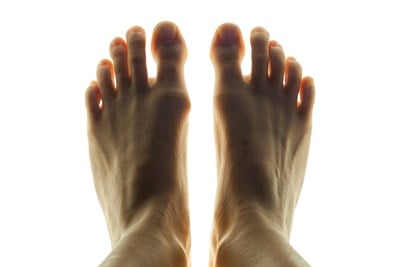A bunion, or “hallux valgus,” is a bump that forms on the base joint of the big toe on the outside edge of the foot. Unlike a corn or callus, this bump isn’t an external formation of skin thickening and hardening. The bump is actually made of the bone—the big toe is forced out of alignment and leans in towards the others, which eventually creates a mass of bone underneath the skin. Here is a look at the causes, symptoms, relief, and prevention of bunions.
Symptoms
Bunions develop over time—and it may take awhile before you even realize one is forming. There may not be any symptoms at all, but in most cases the initial sign is the big toe beginning to bend towards the other toes at the joint where it connects to the metatarsal bones of the foot. Eventually, a small bump will develop at this juncture as well.
The area around the joint may be painful or swollen. The skin at the site of the bump may appear red and begin to thicken to form a callus; skin at the spot where the first and second toes overlap may also form a corn or callus. Eventually, it may become difficult to bend the toe at the affected joint and pain may become persistent—particularly when wearing shoes or walking.
Causes
Although the bones of the big toe being pushed toward the rest of the toes ultimately leads to bunions, this isn’t the primary cause. In fact, certain people are more disposed to develop bunions because of inherited foot structures—these cause issues like pronation that can lead to bunions. Congenital deformities or injuries to the feet may also create bunions because of faulty foot structure or posture.
Although some sources say footwear plays a large role in bunion development, others report it’s unlikely. Additionally, the American Academy of Orthopaedic Surgeons states that while bunions in adolescents are largely because of genetic structures, bunions in adults “are usually associated with long-term wear of narrow, tight shoes.” At the very least, constricting shoes will almost certainly irritate your bunion.
Treatments
Non-Invasive Methods
The severity of the bunion and pain associated with it are significant in deciding an appropriate treatment method. Non-invasive methods might include getting different types of shoes that provide more room and support for the feet; providing a splint or padding to your foot may relieve some of the pain.
Orthotic inserts may also be an option—while they may not specifically get rid of your bunion pain, they will help position your feet to keep the bunion from worsening. Over-the-counter nonsteroidal anti-inflammatories (NSAIDS), prescription steroid injections, or simply icing the area may ease your pain as well.
Invasive Methods
If none of these seem to do the trick, surgery may be necessary: different types of feet, however, will require different types of surgical procedures. In some instances, it may be necessary to remove tissue or part of the bone from around the big toe. Other cases require fusing the toe bones together; other procedures involve straightening the bones back out to remove the lean formed by the big toe.



